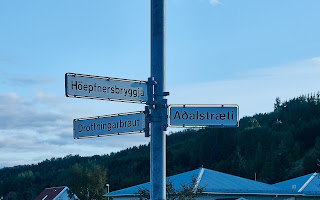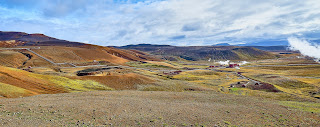On a walk one morning with my friend, Bob James, he mentioned that he was planning a visit in the next few days to Algonquin Park. His plan is to go on his own to do a bit of cross country skiing and maybe some skating and snow shoeing. Bob has been visiting Algonquin Park for a couple of decades in early summer to canoe with friends so he knows the park well. A winter expedition to the park and alone is, I think, a completely new idea. (Click on any photo to enlarge)

A few days later I began to think about Bob's trip and it occurred to me that I have never been to Algonquin Park and it might be fun to join him, a plan to which he agreed. Though I would love to participate in the skiing etc, I will, for fear of injury, pass on these. It would almost certainly, though, be an opportunity to get some interesting photographs.
Wednesday, February 12, departure day, was a beautiful, unusually warm day for mid February, so the 3 hour drive to the town of Huntsville, where we would stay, was uneventful. When we left Dundas there was, essentially, no snow so we were happy to find, as we neared Huntsville, that there was plenty of snow! We arrived at Huntsville around noon to an equally pleasant day with time for an excellent chili lunch, a visit to the LCBO to pick up some wine and some outdoor activities at Arrowhead Park, which is an easy 7 kilometers drive north Huntsville.
 |
| Ski trail at Arrowhead Park |
Arrowhead Park is a beautiful park with, according to my rough calculation, over 30 kilometres of trails for cross country skiing and/or snow shoeing and a 1.3 kilometre ice skating trail! We arrived at the park on this spectacular sunny, calm afternoon with temperatures just below zero and plenty of snow; perfect for any of the winter activities Bob was interested in and for me to get some photos without freezing my fingers even without using my Zippo handwarmers!
 |
| Add caption |

Bob did the ice skating trail twice, just under 3 km total, before skiing some of the excellent trails! These trails are extremely well laid out and maintained. As you might be able to appreciate from some of the photos, they are wide enough for both track skiing and skate skiing. It was a superb afternoon and, though everyday was great, this was, for me, probably the all round best of our time there.
After arriving back in Huntsville we savoured a bit of our Reserva Portuguese wine then an excellent dinner at one of Bob's favourite restaurants.
 |
| Skiing at Arrowhead |
Our plan for Thursday was to return to Arrowhead for a morning skate for Bob and for me to try the snow shoes that I had borrowed from a friend. After Arrowhead we planned to visit another park, Limberlost Forest and Wildlife Reserve, which is also close to Huntsville. The temperature was about minus 12 or 13°C but partly sunny and pleasant so a good day for our planned activities.
 |
| Ski tracks at Arrowhead Park |
At Arrowhead Bob took a couple of trips around the ice skating trail while I attempted the snow shoe trail. Bob succeeded while I, sadly, did not. :-( Shortly after getting underway I twisted my knee and ankle somehow producing enough pain below my knee that I had to abort the showshoeing walk. In addition, though I had previously tested the duration my hand warmers would last (about 6 hours), on this occasion they lost their heat in a couple of hours, so my fingers quickly became too cold to do much with my camera and the camera battery also did not care for the outdoor temperature (though I was surprised at how well it did function when called upon).
The temperature moved up a few degrees as the day progressed so, though still quite cold, it was not bad when we arrived at Limberlost later in the day.
 |
| Ready to ski at Limberlost Reserve |
 |
| Bob setting out on the trail at Linderlost |
Limberlost is privately owned but publicly accessible and, surprisingly, use of the trails is free. Compared to Arrowhead it is, from what we saw, not as well organized. When we found the "main office" I was a bit surprised at the smallness of the building. It consisted of 2 small rooms staffed by one person. Here we received a simple hand drawn map and some information about use of the park trails. From the map we selected a trail for Bob to ski and set out to find it. After a bit of searching we found what we thought was the trail we were looking for. So we set out, Bob on skis and me on foot with my trusty walking sticks. It wasn't long before I had to turn back because my leg was too uncomfortable - Bob continued on and I returned to the car. I tried to walk around a bit and take some pictures but my leg was too uncomfortable to do much. It had now clouded over and seemed to be getting colder. After about an hour or more Bob returned carrying his skis and poles! Apparently we had chosen a hiking/snow shoeing trail which could not be negotiated on skis, a condition which he discovered at a "point of no return". So he finished the trail on foot, skis and poles in hand; much more exercise and fatigue than expected. Under the circumstances we decided to return to motel a bit early where we enjoyed wine and relaxation prior to a tasty dinner of fish and chips!
 |
| Me picking up the rear.(Bob's photo) |
A review of the forecast for Friday foretold a dramatic change in weather with temperatures predicted to drop to around minus 30 degrees celsius! Yikes! We had heard rumours of this but had hoped it would not happen. But it did - we woke in the morning to a temperature of minus 35°C, even colder than predicted! And it was snowing lightly, As I have heard said, "man is an adaptable animal", so we would have to adapt.
We bundled up, loaded the car (at one point we wondered if the car would start after a night at that temperature, but the Subaru started immediately!) and went to breakfast before setting out for the 50 or so kilometer drive to Algonquin Park.
Though very cold, it was sunny and a beautiful day for the drive through Canadian shield rocks that were covered with spectacular formations of ice and snow! We made a note to stop and get some photos on the way home.
 |
| Belgian waffle breakfast |
On the way into the Park we stopped at the Algonquin Outfitters for a bit of shopping before getting to the west entry gate where we bought a pass for the car and trail use. We continued on through the park visiting some of Bob's favourite places, when possible - not all roads to the lakes are open in winter. One stop was at Canoe Lake (where Canadian artist, Tom Thompson, lost his life) where we took a short walk on the lake ice.
 |
| Me on Canoe Lake (Boib's photo) |
 |
| Me on Canoe Lake (Bob's photo) |
From there we drove on to the park Visitors Centre which is another 40 or so kilometres east on highway 60. The Center is an excellent modern facility filled with beautifully appointed historical information, including a well done movie, about the Park. The Center is situated on an elevated area so that one can view from a large deck a panorama of that area of the park, which I attempted to capture in the poor panoramic photo below.
After an excellent informative time in the Visitor's Center we decided to return to the West Gate where Bob could ski one of the trails.
On the way we once again passed a spectacular collection of snow and ice on the rock formations along the highway so we stopped at a couple of them hoping to get some great photographs, one of which is included here.
Back at the West Gate Bob checked out the trails nearby to find one that would be long enough for a comfortable ski and allow him to finish the loop before it was too dark. Having located one that satisfied the criteria he set off.
 |
| Skiing in Algonquin Park |
After Bob's ski outing, we left for Huntsville and another very good dinner and relaxing evening in our motel room.
 |
| Icicles |
Saturday was our departure day but one more ski outing was on the schedule, It was another beautiful sunny morning and the temperature was a reasonable minus 12° C, or so. We decided to return to the West Gate in Algonquin for Bob to repeat the loop he had done the previous day.
That done, we returned to Huntsville and stopped at a restaurant that we liked, had philosophical discussions and reviewed the week over a pizza lunch before departing. And just in time as we noted a rather menacing looking black cloud on the horizon.

The trip home was uneventful and we arrived back in Dundas in time for home cooked dinner. A perfect end to a marvellous four days!
 A few days later I began to think about Bob's trip and it occurred to me that I have never been to Algonquin Park and it might be fun to join him, a plan to which he agreed. Though I would love to participate in the skiing etc, I will, for fear of injury, pass on these. It would almost certainly, though, be an opportunity to get some interesting photographs.
A few days later I began to think about Bob's trip and it occurred to me that I have never been to Algonquin Park and it might be fun to join him, a plan to which he agreed. Though I would love to participate in the skiing etc, I will, for fear of injury, pass on these. It would almost certainly, though, be an opportunity to get some interesting photographs.

 Bob did the ice skating trail twice, just under 3 km total, before skiing some of the excellent trails! These trails are extremely well laid out and maintained. As you might be able to appreciate from some of the photos, they are wide enough for both track skiing and skate skiing. It was a superb afternoon and, though everyday was great, this was, for me, probably the all round best of our time there.
Bob did the ice skating trail twice, just under 3 km total, before skiing some of the excellent trails! These trails are extremely well laid out and maintained. As you might be able to appreciate from some of the photos, they are wide enough for both track skiing and skate skiing. It was a superb afternoon and, though everyday was great, this was, for me, probably the all round best of our time there.

















































